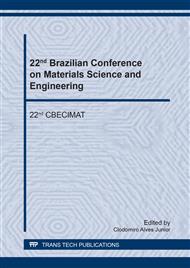[1]
D.V. Magano, I.R.C. Krolow, A.D. Grutzmacher, L.E. Panazzo, F.S. Armas, M. Zimmer, Efeitos secundários de herbicidas aplicados em soja sobre Trichogramma pretiosum ; Pesq. Agrop. Gaúcha, 19, (2013) 69-80.
Google Scholar
[2]
Information on; http//www.agro.basf.com.br/agr/ms/apbrazil/pt_BR/function/conversions:/publish/content/APBrazil/solutions/herbicides/FISPQ/BASAGRAN600.PDF.
Google Scholar
[3]
M.R. Hoffmann, S.T. Martin, W. Choi, D.W. BAhnemann, Environmental Applications of semiconductor photocatalysis. Chemical Reviews, 95, (1995) 69-96.
DOI: 10.1021/cr00033a004
Google Scholar
[4]
L. Liu, X. Chen, Titanium Dioxide Nanomaterials: Self-Structural Modifications. Chemical Reviews. 114, (2014) 9890 − 9918.
DOI: 10.1021/cr400624r
Google Scholar
[5]
M. Yasmina, K. Mourad, S.H. Mohammed, C. Khaoula, Treatment heterogeneous photocatalysis; factors influencing the photocatalytic degradation by TiO2. Energy Procedia, 50, (2014) 559-566.
DOI: 10.1016/j.egypro.2014.06.068
Google Scholar
[6]
A. Pandey, S. Kalal, C. Ameta, R. Ameta, S. Kumar, P.B. Punjabi, Synthesis, characterization and application of naïve and nano-sized titanium dioxide as a photocatalyst for degradation of methylene blue. Journal of Saudi Chemical Society.
DOI: 10.1016/j.jscs.2015.05.013
Google Scholar
[7]
C. Belver, J. Bedia, J. Rodriguez., J.Titania–clay heterostructures with solar photocatalytic applications. Applied Catalysis B: Environmental,176, (2015) 278-287.
DOI: 10.1016/j.apcatb.2015.04.004
Google Scholar
[8]
J. Zhang, L. Zhang, J. Lv, S. Zhou, H. Chen, Y. Zhao, X. Wang, Exceptional visible-light-induced photocatalytic activity of attapulgite-BiOBr-TiO2 nanocomposites. Applied Clay Science, 90, (2014) 135-140.
DOI: 10.1016/j.clay.2013.12.037
Google Scholar
[9]
E. Kordouli, K. Bourikas, A. Lycourghiotis, C. Kordulis, The mechanism of azo-dyes adsorption on the titanium dioxide surface and their photocatalytic degradation over samples with various anatase /rutile ratios. Catalysis Today, 252, (2015).
DOI: 10.1016/j.cattod.2014.09.010
Google Scholar
[10]
J. Andersen, M. Pelaez, L. Guay, Z. Zhang, K. O'shea, D.D. Dionysiou, NF-TiO2 photocatalysis of amitrole and atrazine with addition of oxidants under simulated solar light: emerging synergies, degradation intermediates, and reusable attributes. Journal of Hazardous Materials, 260, (2013).
DOI: 10.1016/j.jhazmat.2013.05.056
Google Scholar
[11]
E.I. Seck, D.J.M. Rodríguez, F.C. Rodríguez, G.O.M. Díaz, J. Araña, P.J. Peña, Photocatalytical removal of bentazon using commercial and sol–gel synthesized nanocrystalline TiO2: Operational parameters optimization and toxicity studies. Chemical Engineering Journal, 203, (2012).
DOI: 10.1016/j.cej.2012.06.119
Google Scholar
[12]
N. Vela, J. Fenoll, I. Garrido, G. Navarro, M. Gambin, S. Navarro, Photocatalytic mitigation of triazinone herbicide residues using titanium dioxide in slurry photoreactor. Catalysis Today, 252, (2015) 70 – 72.
DOI: 10.1016/j.cattod.2014.12.011
Google Scholar
[13]
L. Yassumoto, J.A. Osajima, K. Takashima, Efeitos de oxidantes e sais inorgânicos na degradação fotocatalítica do herbicida imazetapir mediada por dióxido de titânio. Eclética Química, 32, (2007) 27-32.
DOI: 10.1590/s0100-46702007000100004
Google Scholar
[14]
G.R.M. Echavia, F. Matzusawa, N. Negishi, Photocatalytic degradation of organophosphate and phosphonoglycine pesticide using TiO2 immobilized on silica gel. Chemosphere, 76, (2009) 595 – 600.
DOI: 10.1016/j.chemosphere.2009.04.055
Google Scholar
[15]
B.J. Martijn, P.C. Kamp, J.C. Kruithof, UV/H2O2 Treatment: An Essential Barrier in a Multi Barrier Approach For Organic Contaminant Control. IUVA News, 10, (2008) 11 – 19.
Google Scholar
[16]
N.A. Mir, M.M. Haque, A. Khan, M. Muneer, C. Boxall, (. Photoassisted degradation of a herbicide derivative, dinoseb, in aqueous suspension of titania., The Scientific World Journal.
DOI: 10.1100/2012/251527
Google Scholar
[17]
K.A.S. Coelho, Fotólise e fotocatálise do herbicida basagran em solução aquosa. Dissertação de Mestrado em Agronomia. Universidade Federal do Piauí. (2013).
Google Scholar
[18]
P. W. Atkins, Physical Chemistry.(6th ed). Rio de Janeiro: Brasil (2002).
Google Scholar
[19]
L. Zhang, F. Lv, W. Zhang, R. Li, H. Zhong, Y. Zhao, Y. Zhang, X. Wang,. Photodegradation of methylorange by attapulgite–SnO2–TiO2 nanocomposites. Journal of Hazardous Materials, 171 (2009) 294-300.
DOI: 10.1016/j.jhazmat.2009.05.140
Google Scholar


